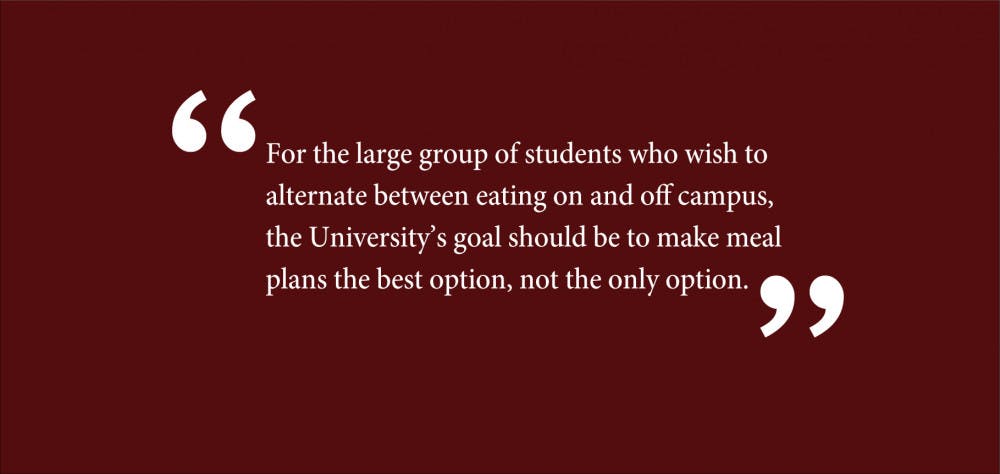Like most students, I put up with meal plan during my first year on campus. Mostly because I didn’t have a choice — all first-years are required to purchase a meal plan. Paying $6 for 12 ounces of soup violated every lesson my parents taught me on the virtues of frugality.
Paying a high price for food continues to frustrate and anger me. “Next year I’ll eat off campus more, and save some money,” I said, gritting my teeth as I paid $4 for an Uncrustable. Fast-forward to the beginning of sophomore year; I started researching meal plan options with the intention of cutting my plan in half and using the savings to eat off-campus. I soon discovered this was impossible. Every mid-sized meal plan is so outrageously priced that alternating between on- and off-campus eating is far more expensive than purchasing a full meal plan, or only eating off campus. For me, going off meal plan entirely wasn’t an option — I wanted to be able to participate in the social experience of Brown dining, so I sucked it up and stayed on the full plan. If you’re like me, and you care about being able to get dinner with your friends at the Sharpe Refectory, Brown’s got you in a double bind. You can either pay through the nose to eat partly on, partly off campus, or you can buy Brown’s biggest plan. It’s a win-win for Brown, and a lose-lose for the rest of us.
Let me explain. When it comes to meal plans, the biggest ones are, of course, the best value. If there are roughly 30 weeks in the academic year, 20 meals per week and Flex 460 will run you about $8.89 and $10.65 per meal, respectively. Dropping from 20 to 10 meals per week saves you roughly $810. You may think that’s a nice chunk of change until you realize you just lost half your meals but only saved roughly 15 percent.
What about the off-campus plan, you might ask? In truth, it’ll save you a boatload — as it should, given that you’re only getting 50 meals and 500 points per year. But you’ll also be paying the shameful price of $35.40 per meal credit — at this point, you could forgo a lunch at the Ratty, eat at Andrea’s and still have change left to do your laundry.
Certainly there are some students that can’t wait to go off meal plan completely and cook for themselves or get Baja’s three times a day — but for most students such an arrangement is inconvenient, undesirable or both. Sometimes you just want Jo’s at 1:00 a.m. or dinner with friends at the Ratty. So, for this large group of students who want to eat some, but not all, meals off campus, Brown has us trapped. We can either go off meal plan completely, or switch to a smaller plan and pay an outrageous sum for breakfast at the V-Dub.
While I ultimately chose to stay on the full plan, for some that isn’t an option. I’ve been able to afford staying on meal plan, but others cannot. They’re the ones hurt most by this price structure. Since they can’t afford to eat every meal on campus, and alternating between on- and off-campus meals is even more expensive, they get squeezed out of Brown dining entirely. Anyone who has made a close friend simply by sharing meals at the Ratty (I count myself among these) can see the problem. Whether we recognize it or not, the dining experience builds community. The dining halls are where students gather to form, maintain and strengthen friendships. Brown’s price structure deprives these students of that opportunity. In recent years, Brown has made efforts to address food security (including offering low-income students funds for meal plans). These efforts are noble, but the lack of reasonably priced, medium-sized plans detracts from them.
The solution seems obvious: a meal plan, let’s say 10 meals per week, that costs around $10 or $11 per meal (rather than $15.47). With a plan like that, the University would continue to incentivize purchasing the bigger plans, and students would not be getting fleeced if they want to cook or eat by CHLOE a few times a week. Other universities already do this. The costs per meal of Johnson and Wales’ 18 and 10 meals per week plans are $8.01 and $9.20, respectively. And at Rhode Island College, their 19 and 10 meals per week plans cost $8.51 and $10.96 per meal, respectively.
Currently, there is no clear incentive for Brown to offer such a plan — after all, it could cost the University some revenue. But I’d argue it isn’t obvious that would be the case. A survey from a few years ago found that roughly 19 percent of students are not on meal plan. From speaking to some of those students myself, many want to purchase a small plan — only none are reasonably priced. Rather than offer such a plan, Brown has doubled down on the current structure and, in doing so, forced its students into making an unnecessary choice between expensive and inconvenient eating.
I would never argue that the University shouldn’t offer wholesale discounts. And the line between incentivizing and manipulating can be faint. But any fair-minded assessment would conclude that, with the current structure, the University has crossed that line with room to spare.
For the large group of students who wish to alternate between eating on and off campus, the University’s goal should be to make meal plans the best option, not the only option.
Andrew Reed ‘21 can be reached andrew_reed@brown.edu. Please send responses to this opinion to letters@browndailyherald.com and op-eds to opinions@browndailyherald.com.





